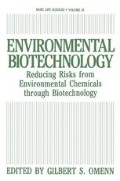Abstract
The ability of bacteria to convert inorganic and organic mercury compounds to less toxic, volatile elemental mercury is among the most widely found plasmid-determined bacterial phenotypes. It is the best understood microbial metal transformation at levels of analysis from molecular genetics and biochemistry to population biology (4, 14). Mercury compounds are important contaminants in some environmental sites.
Access this chapter
Tax calculation will be finalised at checkout
Purchases are for personal use only
Preview
Unable to display preview. Download preview PDF.
References
Barkay, T., L. Fouts, and B.H. Olson (1985) A method for the detection of mercury resistance genes in natural bacterial isolates. Appl. Env. Microbiol. 49:686–692.
Begley, T.P., A.E. Walts, and C.T. Walsh (1986) Bacterial organomercurial lyase: Overproduction, isolation, and characterization. Biochemistry 25:7186–7192.
Begley, T.P., A.E. Walts, and C.T. Walsh (1986) Mechanistic studies of a protonolytic organomercurial cleaving enzyme: Bacterial organomercurial lyase. Biochemistry 25:7193.
Foster, T.J. (1987) Genetics and biochemistry of mercury resistance. CRC Crit. Rev, in Microbiol.
Griffin, H.G., T.J. Foster, S. Silver, and T.K. Misra (1987) Cloning and DNA sequence of the mercuric and organomercurial resistance determinants of plasmid pDU1358. Proc. Natl. Acad. Sci., USA 84:3112–3116.
Heltzel, A., D.G. Gambill, W.J. Jackson, P.A. Totis, and A.O. Summers (1987) Overexpression and DNA-binding properties of the merencoding regulatory protein from plasmid NR1 (Tn21.). J. Bact. 169: 3379–3384.
Laddaga, R.A., L. Chu, T.K. Misra, and S. Silver (1987) Nucleotide sequence and expression of the mercurial-resistance operon from Staphylococcus aureus plasmid pI258. Proc. Natl. Acad. Sci., USA 84:5106–5110.
Lund, P.A., and N.L. Brown (1987) Role of the merT and merP gene products of transposon Tn501 in the induction and expression of resistance to mercuric ions. Gene 52:207–214.
Lund, P.A., S.J. Ford, and N.L. Brown (1986) Tran scriptional regulation of the mercury-resistance genes of transposon Tn501. J. Gen. Microbiol. 132:465–480.
Miller, S.M., D.P. Ballou, V. Massey, C.H. Williams, Jr., and C.T. Walsh (1986) Two-electron reduced mercuric reductase binds Hg(II) to the active site dithiol but does not catalyze Hg(II) reduction. J. Biol. Chem.
Nakahara, H., J.L. Schottel, T. Yamada, Y. Miyakawa, M. Asakawa, J. Harville, and S. Silver (1985) Mercuric reductase enzymes from Streptomyces species and group B Streptococcus. J. Gen. Microbiol. 131:1053–1059.
O’Halloran, T., and C. Walsh (1987) Metalloregulatory DNA-binding protein encoded by the merR gene: Isolation and characterization. Science 235:211–214.
Schultz, P.G., K.G. Au, and C.T. Walsh (1985) Directed mutagenesis of the redox-active disulfide in the flavoenzyme mercuric ion reductase. Biochem. 26:6840–6848.
Summers, A.O. (1986) Organization, expression, and evolution of genes for mercury resistance. Ann. Rev. Microbiol. 40:607–634.
Author information
Authors and Affiliations
Editor information
Editors and Affiliations
Rights and permissions
Copyright information
© 1988 Springer Science+Business Media New York
About this chapter
Cite this chapter
Summers, A.O. (1988). Biotransformations of Mercury Compounds. In: Omenn, G.S. (eds) Environmental Biotechnology. Basic Life Sciences, vol 45. Springer, Boston, MA. https://doi.org/10.1007/978-1-4899-0824-7_7
Download citation
DOI: https://doi.org/10.1007/978-1-4899-0824-7_7
Publisher Name: Springer, Boston, MA
Print ISBN: 978-1-4899-0826-1
Online ISBN: 978-1-4899-0824-7
eBook Packages: Springer Book Archive

